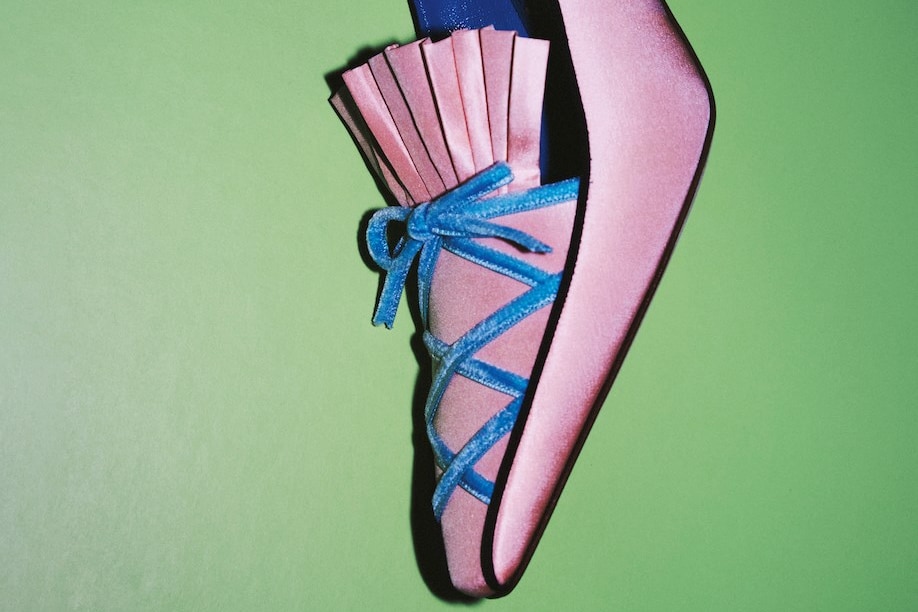
Rewrite
Lead ImageRohan pump in silk from the Marie Antoinette by Manolo Blahnik collection by MANOLO BLAHNIK
This story is taken from the Autumn/Winter 2025 issue of AnOther Magazine:
Manolo Blahnik grew up with Marie Antoinette. Not literally, of course – she died in France in 1793, and Blahnik was born on La Palma in the Canary Islands 149 years later. But he has been obsessed with the ill-fated queen since childhood – a memory that has lingered and shaped the way he has designed women’s shoes for some 55 years.
“Somehow I saw a film,” Blahnik says. “I don’t remember the title now … L’impératrice or something. It was like a documentary type of film they show before a children’s movie. And it was a little short on Marie Antoinette.” Besides that, he also had unusual bedtime stories. “When I was a boy I had nightmares, so my mother came to read to me, to comfort me. She read Stefan Zweig’s Marie Antoinette. These are the beginnings of my fixation.”
The ill-fated life story of Marie Antoinette is not the usual fairy tale told to children. But it led to a fixation that, of course, has a connection to Blahnik’s other passion: designing shoes. Marie Antoinette was particularly well shod – shoes had become a big deal at the French court under Louis XIV, who originated the notion of talons rouge (red heels) that could only be worn by the highest level of aristocracy. During Marie Antoinette’s 18-year reign as queen of the French, etiquette dictated she had four new pairs hand-made each week, whether she needed them or not. As Zweig wrote, “Obviously, moreover, a queen needed larger diamonds and thicker strings of pearls than any other woman. She must have more rings and circlets and bracelets and brilliants and hair chains and gems, finer shoe buckles and more bejewelled borders to the fans painted by Fragonard, than the wives of his Majesty’s younger brothers, or any other ladies of the court.”
Like so much else, those bracelets and brilliants and hair chains and her hundreds of pairs of shoes were scattered after an attack on the Tuileries Palace in 1792, where the royal family were living. Marie Antoinette’s wardrobe – a source of ire for the French, who dubbed her Madame Déficit for her profligate spending – was ransacked. Her shoes even came up before the Revolutionary Tribunal that decided her fate – the court’s president, Armand Herman, decried her pre-revolutionary habit of ordering more than she could ever wear. Today, a single shoe, torn from the hands of those Tuileries invaders by a grenadier, sits in the collection of the Musée Carnavalet in Paris. With its delicately turned Louis heel, fine silk faille body and knotted ribbon bow, it could have been pulled from one of Blahnik’s collections.
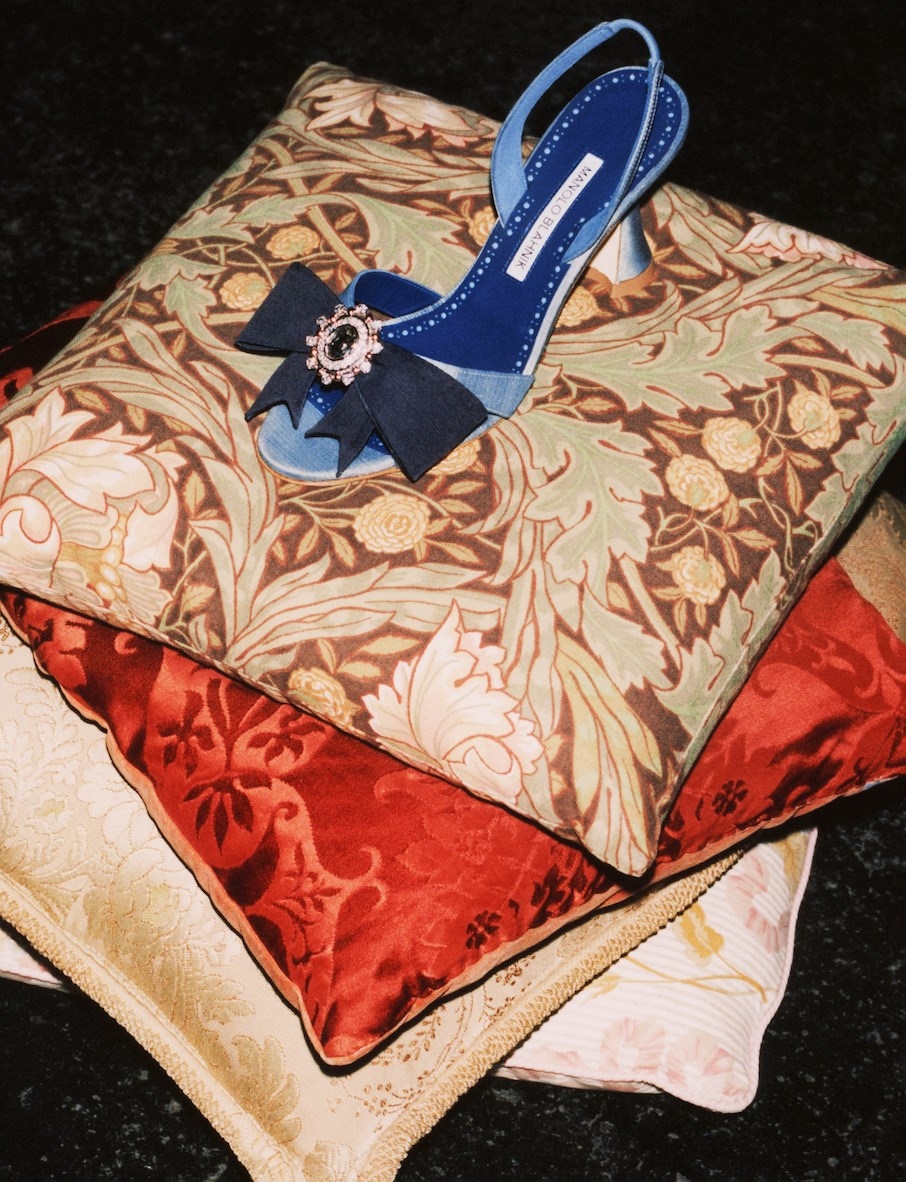
And indeed, he has designed shoes for Marie Antoinette – of a fashion. His shoes featured on the feet of Kirsten Dunst as the young queen in Sofia Coppola’s 2006 feature film charting her life and times, and its costume designer, Milena Canonero, won an Academy Award for her efforts. “I got a call and they said, ‘Marie Antoinette!’ I didn’t even know what it was, but I said, ‘Yes.’ Can you imagine? How crazy.” Canonero’s brief to Blahnik was to ignore history and think of the woman. “Think what Marie Antoinette would have wanted if she had come to you for shoes.” Blahnik hand-made them himself, one of the few fashion talents with the ability to do that, in shoes or dress.
“Obviously, moreover, a queen needed larger diamonds and thicker strings of pearls than any other woman” – Stefan Zweig
Blahnik today, aged 82, looks divine, which is one of his favourite words. He says it no fewer than seven times during our conversation, variously in reference to the designer Azzedine Alaïa, the actress Delphine Seyrig and of course Marie Antoinette. He has a patrician nose and swept-back white hair that seems to belong to the 18th century, although his sharply cut suits, bow ties and bicoloured shoes – a men’s style, for a long period the only one his company offered, naturally named Manolo – suggest a dandy of the 1930s. His politesse and refinement seem of another time too.
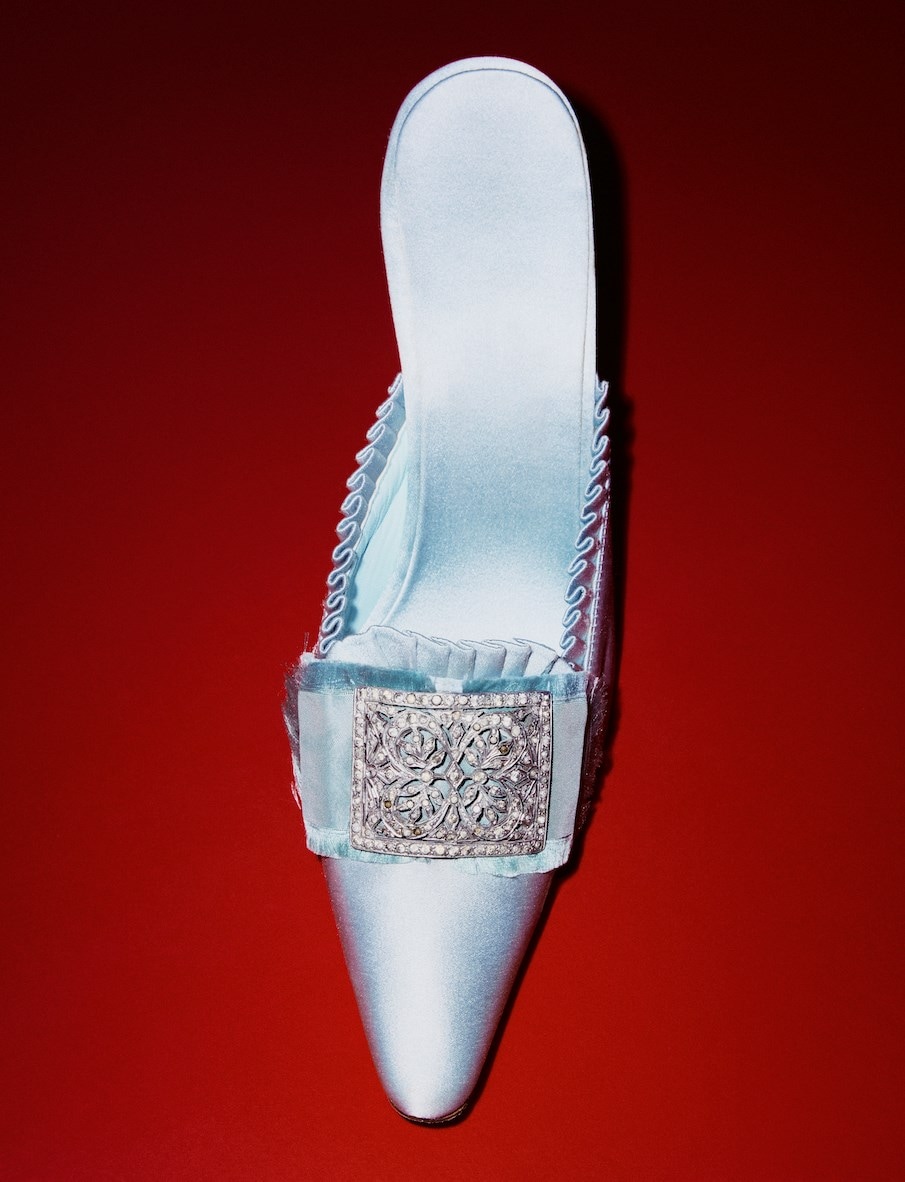
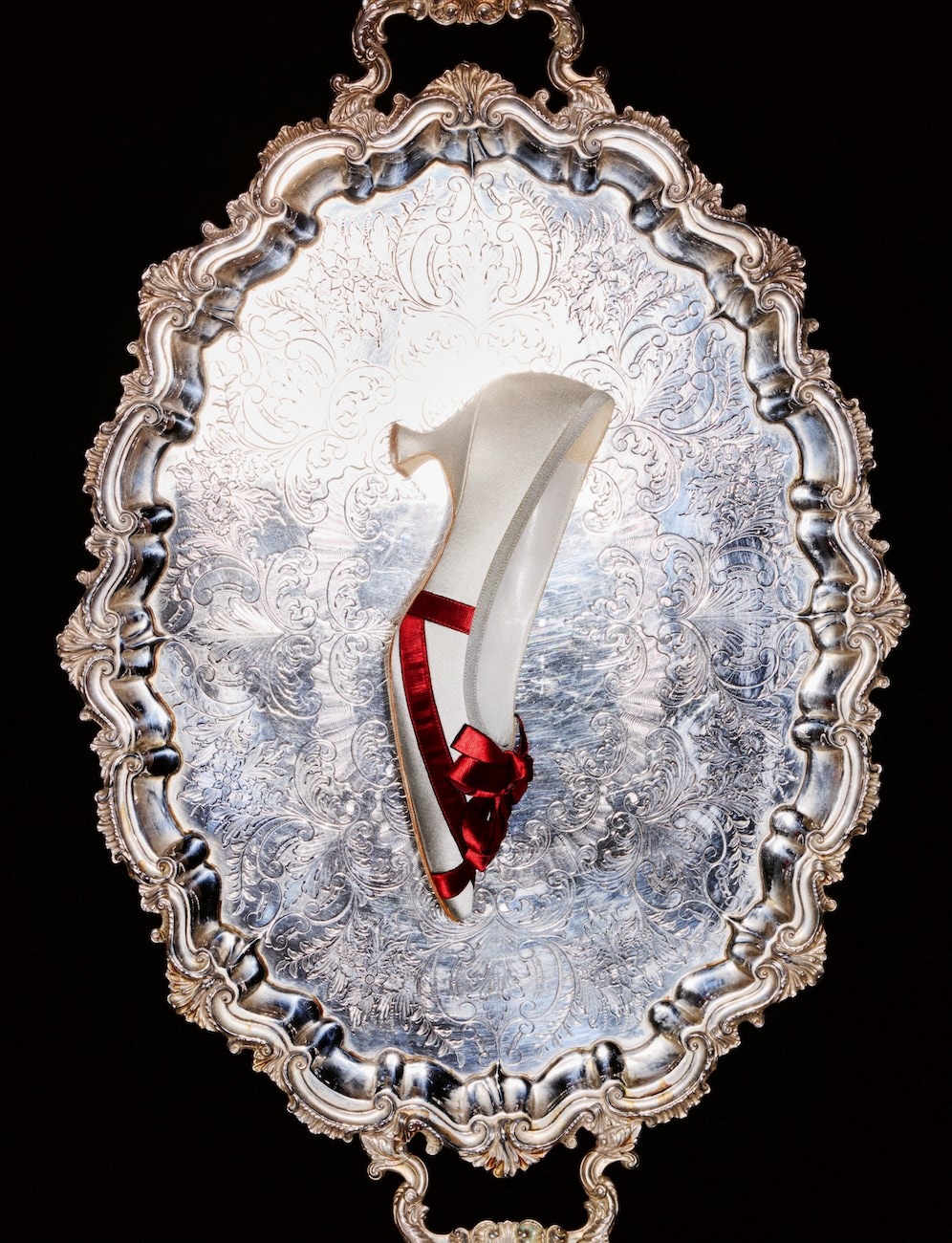
Blahnik’s designs for Marie Antoinette – the reality of the film and the fantasy of the queen – are now showcased as part of an exhibition at the Victoria and Albert Museum examining the style of the queen and her enduring influence, running until almost the end of March 2026. “It’s extraordinary how she manages – her spirit, her soul, her influence – to be always present, each decade. We go back to Marie Antoinette,” Blahnik says. He’s speaking in London a few months before the opening of the exhibition, which will feature half a dozen of his shoe designs. The colour of macarons, executed in silk satins and velvet with original 1700s buckles perched on the vamp, the styles were, appropriately enough, based on the close study of original 18th-century examples held in the museum’s archives. Blahnik traces a finger along the curve of a heel ruefully and frowns at the stains inside a couple of pairs. His favourite ones are those that remain unworn – pristine and perfect, unsoiled by the realities of those Hollywood fantasies.
Blahnik has strong views on Marie Antoinette’s various storytellers. He adores Antonia Fraser. “Don’t you love her? What she does?” he asks – although, of course, it’s rhetorical. “It’s fabulous research – she found letters of her mother, letters for the brothers, letters to Maria Carolina in Naples,” who was Marie Antoinette’s sister. By contrast, with equal passion he loathes a recent BBC adaptation. “It’s so bad.” And, luckily, he adores – his voice rising an octave as he says so – Dunst in Coppola’s movie, “which is the only modern movie to capture the spirit of the young Marie Antoinette”. Other than that, he loves the extreme 1938 version starring Norma Shearer – the wife of its producer Irving Thalberg – where, among other excesses, the ballroom of Versailles was built twice its actual size, to allow for long shots. “Everything was wrong. Everything completely wrong,” Blahnik says. “Nothing mattered. Tyrone Power – sweet, but he was not Count von Fersen. It was very well done. I mean, an MGM production – the production designer was Cedric Gibbons. Costumes, Adrian. The photography was extraordinary. But that film, I saw it when I was young … I thought it was exquisite.”
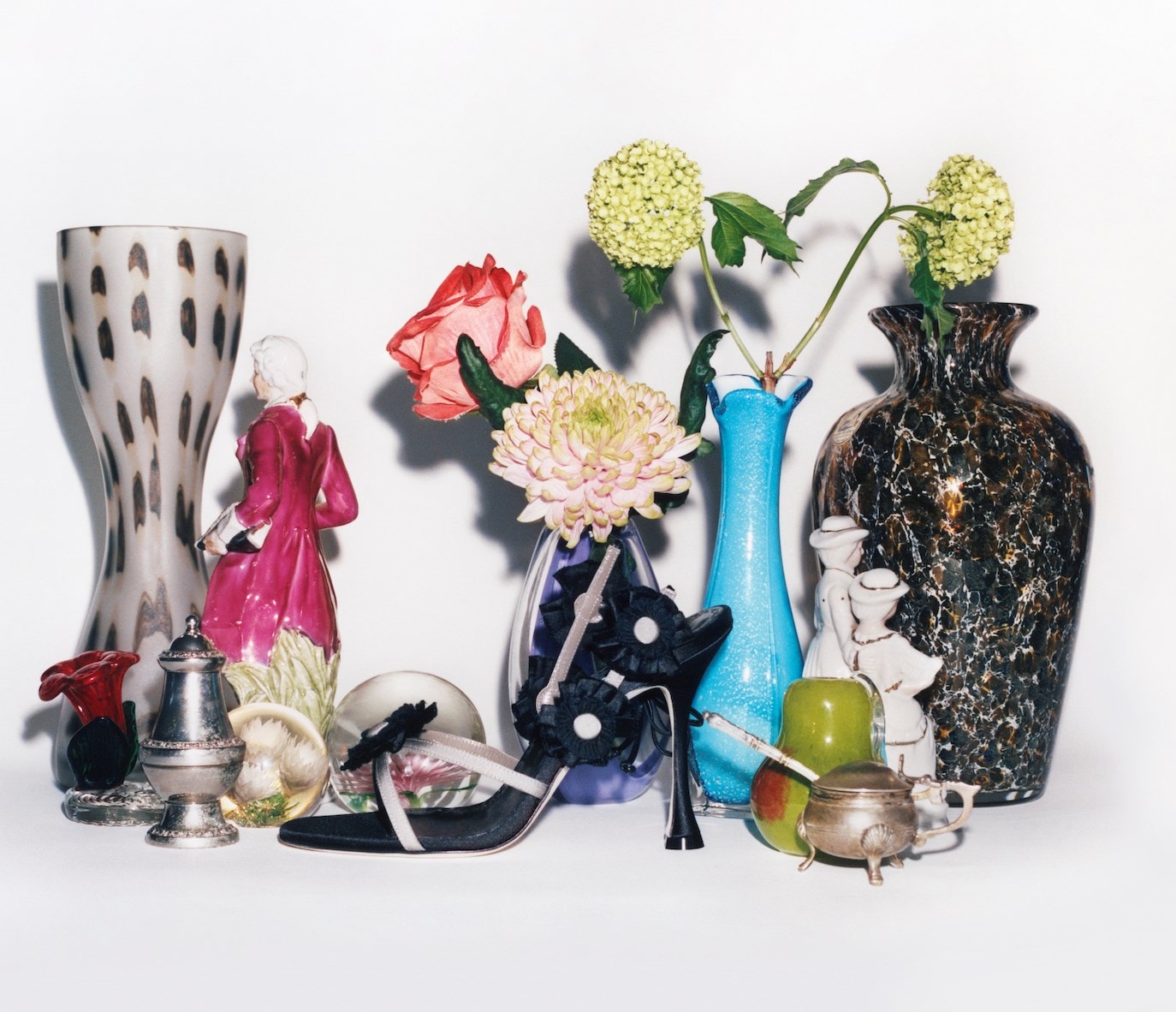
You can understand its attraction for Blahnik, whose shoes – distinctly feminine, endlessly inventive – have always had a touch of the extreme. He was discovered by Diana Vreeland, herself the most extreme of extremes, who told him there and then to “Focus on extremities, young man. Do shoes.” That was in 1970, in New York, when Vreeland still reigned supreme as editor-in-chief of American Vogue. His first shoes, debuted in a show by the designer Ossie Clark the following year, were also extreme. Blahnik constructed them from royal blue suede, coloured acid green inside, with a sole made of “beautifully white” crepe rubber. He didn’t, however, know to put a steel spine inside the heels, a rookie mistake, so the rubbery footwear made the models wobble and tremble. Blahnik thought it was a disaster, but after the show David Hockney and Cecil Beaton congratulated him on the unique gait he’d designed. Clark was thrilled.
“Manolo Blahnik’s shoes are as good as sex” – Madonna
There are stories that prisoners in the Conciergerie passed around a shoe worn by Marie Antoinette when she was taken to the scaffold and fervently kissed it – a degree of fervour matched by admirers of Blahnik’s. “Manolo Blahnik’s shoes are as good as sex,” Madonna once said, and his name has become a sweet nothing to be whispered into the ear of ardent retifists. To satisfy royalists and Manolo loyalists who may fetishise Marie Antoinette’s shoes, Blahnik is releasing a capsule of 12 pairs, some of which are close reinterpretations of specific styles glimpsed in the film. There’s also a finely striped shoe based specifically on a portrait of the queen in a striped jacket by Adolf Ulrik Wertmüller from 1788, and others more generally evocative of her aesthetic in satin decorated with swirling rosettes, pleats and brooches.
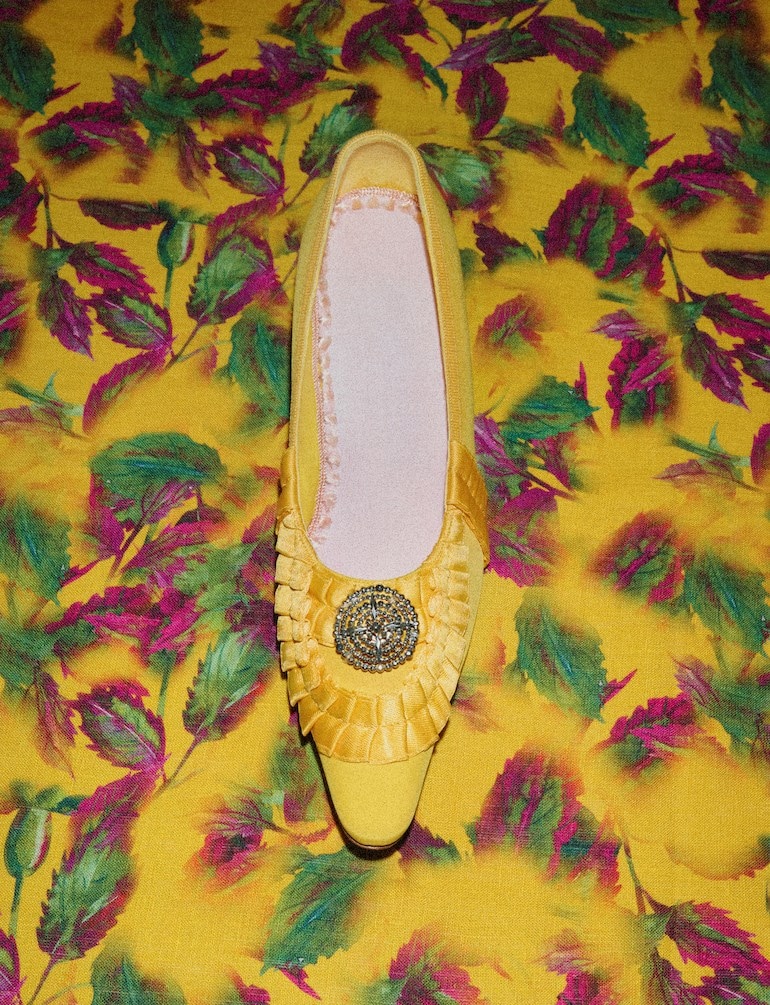
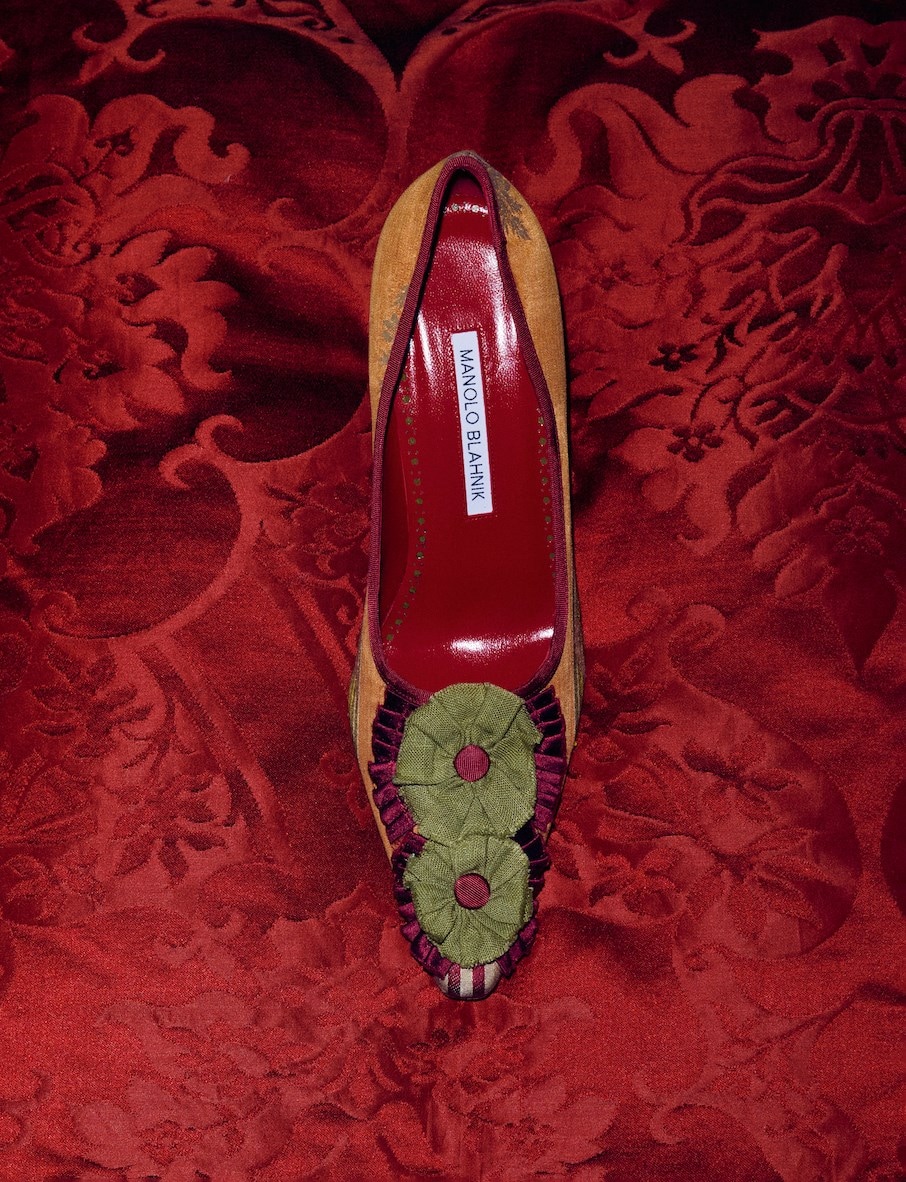
They all seem distinctly Blahnik – because he never really strays very far from Marie Antoinette. “I have moments that I just fantasise about colours, pleats, bows. And then I forget, and then back again. It’s always something that’s attracted me,” he says. “I don’t know why, don’t ask me. Certainly it’s because I grew up with this history.” Blahnik, indeed, is a voracious historian, obsessively absorbing details of paintings and feeding them back into his work, so shoes may be homages to Zurbarán or Luchino Visconti or his own Spanish childhood. But Marie Antoinette is the one he always returns to.
Set design: Staci Lee at Bryant Artists. Photographic assistants: Pietro Lazzaris and Federico Covarelli. Set-design assistant: Jessa Thorpe. Production: 360PM. Executive producers: Carole Cieutat and Azra Moraca-Savva. Production co-ordinators: Julia Lellouche and Gillian Panuncialman. Post-production: Imagine
The Autumn/Winter 2025 issue of AnOther Magazine is on sale internationally now. Buy a copy here.
in HTML format, including tags, to make it appealing and easy to read for Japanese-speaking readers aged 20 to 40 interested in fashion. Organize the content with appropriate headings and subheadings (h1, h2, h3, h4, h5, h6), translating all text, including headings, into Japanese. Retain any existing
tags from
Lead ImageRohan pump in silk from the Marie Antoinette by Manolo Blahnik collection by MANOLO BLAHNIK
This story is taken from the Autumn/Winter 2025 issue of AnOther Magazine:
Manolo Blahnik grew up with Marie Antoinette. Not literally, of course – she died in France in 1793, and Blahnik was born on La Palma in the Canary Islands 149 years later. But he has been obsessed with the ill-fated queen since childhood – a memory that has lingered and shaped the way he has designed women’s shoes for some 55 years.
“Somehow I saw a film,” Blahnik says. “I don’t remember the title now … L’impératrice or something. It was like a documentary type of film they show before a children’s movie. And it was a little short on Marie Antoinette.” Besides that, he also had unusual bedtime stories. “When I was a boy I had nightmares, so my mother came to read to me, to comfort me. She read Stefan Zweig’s Marie Antoinette. These are the beginnings of my fixation.”
The ill-fated life story of Marie Antoinette is not the usual fairy tale told to children. But it led to a fixation that, of course, has a connection to Blahnik’s other passion: designing shoes. Marie Antoinette was particularly well shod – shoes had become a big deal at the French court under Louis XIV, who originated the notion of talons rouge (red heels) that could only be worn by the highest level of aristocracy. During Marie Antoinette’s 18-year reign as queen of the French, etiquette dictated she had four new pairs hand-made each week, whether she needed them or not. As Zweig wrote, “Obviously, moreover, a queen needed larger diamonds and thicker strings of pearls than any other woman. She must have more rings and circlets and bracelets and brilliants and hair chains and gems, finer shoe buckles and more bejewelled borders to the fans painted by Fragonard, than the wives of his Majesty’s younger brothers, or any other ladies of the court.”
Like so much else, those bracelets and brilliants and hair chains and her hundreds of pairs of shoes were scattered after an attack on the Tuileries Palace in 1792, where the royal family were living. Marie Antoinette’s wardrobe – a source of ire for the French, who dubbed her Madame Déficit for her profligate spending – was ransacked. Her shoes even came up before the Revolutionary Tribunal that decided her fate – the court’s president, Armand Herman, decried her pre-revolutionary habit of ordering more than she could ever wear. Today, a single shoe, torn from the hands of those Tuileries invaders by a grenadier, sits in the collection of the Musée Carnavalet in Paris. With its delicately turned Louis heel, fine silk faille body and knotted ribbon bow, it could have been pulled from one of Blahnik’s collections.

And indeed, he has designed shoes for Marie Antoinette – of a fashion. His shoes featured on the feet of Kirsten Dunst as the young queen in Sofia Coppola’s 2006 feature film charting her life and times, and its costume designer, Milena Canonero, won an Academy Award for her efforts. “I got a call and they said, ‘Marie Antoinette!’ I didn’t even know what it was, but I said, ‘Yes.’ Can you imagine? How crazy.” Canonero’s brief to Blahnik was to ignore history and think of the woman. “Think what Marie Antoinette would have wanted if she had come to you for shoes.” Blahnik hand-made them himself, one of the few fashion talents with the ability to do that, in shoes or dress.
“Obviously, moreover, a queen needed larger diamonds and thicker strings of pearls than any other woman” – Stefan Zweig
Blahnik today, aged 82, looks divine, which is one of his favourite words. He says it no fewer than seven times during our conversation, variously in reference to the designer Azzedine Alaïa, the actress Delphine Seyrig and of course Marie Antoinette. He has a patrician nose and swept-back white hair that seems to belong to the 18th century, although his sharply cut suits, bow ties and bicoloured shoes – a men’s style, for a long period the only one his company offered, naturally named Manolo – suggest a dandy of the 1930s. His politesse and refinement seem of another time too.


Blahnik’s designs for Marie Antoinette – the reality of the film and the fantasy of the queen – are now showcased as part of an exhibition at the Victoria and Albert Museum examining the style of the queen and her enduring influence, running until almost the end of March 2026. “It’s extraordinary how she manages – her spirit, her soul, her influence – to be always present, each decade. We go back to Marie Antoinette,” Blahnik says. He’s speaking in London a few months before the opening of the exhibition, which will feature half a dozen of his shoe designs. The colour of macarons, executed in silk satins and velvet with original 1700s buckles perched on the vamp, the styles were, appropriately enough, based on the close study of original 18th-century examples held in the museum’s archives. Blahnik traces a finger along the curve of a heel ruefully and frowns at the stains inside a couple of pairs. His favourite ones are those that remain unworn – pristine and perfect, unsoiled by the realities of those Hollywood fantasies.
Blahnik has strong views on Marie Antoinette’s various storytellers. He adores Antonia Fraser. “Don’t you love her? What she does?” he asks – although, of course, it’s rhetorical. “It’s fabulous research – she found letters of her mother, letters for the brothers, letters to Maria Carolina in Naples,” who was Marie Antoinette’s sister. By contrast, with equal passion he loathes a recent BBC adaptation. “It’s so bad.” And, luckily, he adores – his voice rising an octave as he says so – Dunst in Coppola’s movie, “which is the only modern movie to capture the spirit of the young Marie Antoinette”. Other than that, he loves the extreme 1938 version starring Norma Shearer – the wife of its producer Irving Thalberg – where, among other excesses, the ballroom of Versailles was built twice its actual size, to allow for long shots. “Everything was wrong. Everything completely wrong,” Blahnik says. “Nothing mattered. Tyrone Power – sweet, but he was not Count von Fersen. It was very well done. I mean, an MGM production – the production designer was Cedric Gibbons. Costumes, Adrian. The photography was extraordinary. But that film, I saw it when I was young … I thought it was exquisite.”

You can understand its attraction for Blahnik, whose shoes – distinctly feminine, endlessly inventive – have always had a touch of the extreme. He was discovered by Diana Vreeland, herself the most extreme of extremes, who told him there and then to “Focus on extremities, young man. Do shoes.” That was in 1970, in New York, when Vreeland still reigned supreme as editor-in-chief of American Vogue. His first shoes, debuted in a show by the designer Ossie Clark the following year, were also extreme. Blahnik constructed them from royal blue suede, coloured acid green inside, with a sole made of “beautifully white” crepe rubber. He didn’t, however, know to put a steel spine inside the heels, a rookie mistake, so the rubbery footwear made the models wobble and tremble. Blahnik thought it was a disaster, but after the show David Hockney and Cecil Beaton congratulated him on the unique gait he’d designed. Clark was thrilled.
“Manolo Blahnik’s shoes are as good as sex” – Madonna
There are stories that prisoners in the Conciergerie passed around a shoe worn by Marie Antoinette when she was taken to the scaffold and fervently kissed it – a degree of fervour matched by admirers of Blahnik’s. “Manolo Blahnik’s shoes are as good as sex,” Madonna once said, and his name has become a sweet nothing to be whispered into the ear of ardent retifists. To satisfy royalists and Manolo loyalists who may fetishise Marie Antoinette’s shoes, Blahnik is releasing a capsule of 12 pairs, some of which are close reinterpretations of specific styles glimpsed in the film. There’s also a finely striped shoe based specifically on a portrait of the queen in a striped jacket by Adolf Ulrik Wertmüller from 1788, and others more generally evocative of her aesthetic in satin decorated with swirling rosettes, pleats and brooches.


They all seem distinctly Blahnik – because he never really strays very far from Marie Antoinette. “I have moments that I just fantasise about colours, pleats, bows. And then I forget, and then back again. It’s always something that’s attracted me,” he says. “I don’t know why, don’t ask me. Certainly it’s because I grew up with this history.” Blahnik, indeed, is a voracious historian, obsessively absorbing details of paintings and feeding them back into his work, so shoes may be homages to Zurbarán or Luchino Visconti or his own Spanish childhood. But Marie Antoinette is the one he always returns to.
Set design: Staci Lee at Bryant Artists. Photographic assistants: Pietro Lazzaris and Federico Covarelli. Set-design assistant: Jessa Thorpe. Production: 360PM. Executive producers: Carole Cieutat and Azra Moraca-Savva. Production co-ordinators: Julia Lellouche and Gillian Panuncialman. Post-production: Imagine
The Autumn/Winter 2025 issue of AnOther Magazine is on sale internationally now. Buy a copy here.
and integrate them seamlessly into the new content without adding new tags. Ensure the new content is fashion-related, written entirely in Japanese, and approximately 1500 words. Conclude with a “結論” section and a well-formatted “よくある質問” section. Avoid including an introduction or a note explaining the process.


